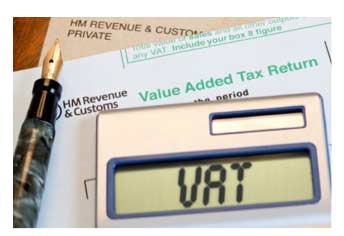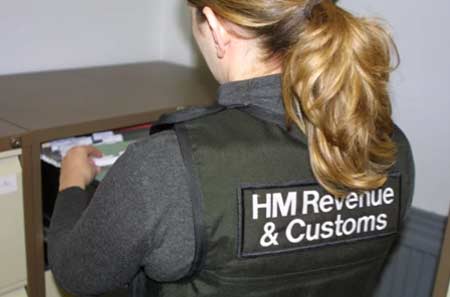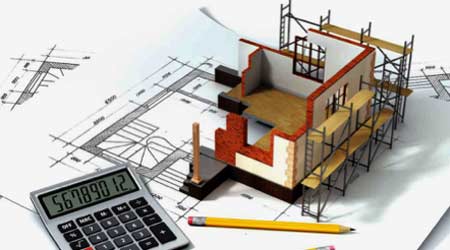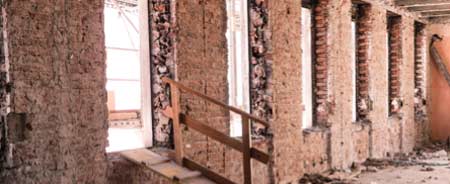The rules about VAT can be challenging but they are relatively logical if you get a good feel for what they are trying to tax. We have a project all about self builds and how to reclaim your VAT here, but here we will give you an overview of VAT and how it is applied to other projects, not just new self-builds.
We outline the situations where you might be able to avoid VAT – which is legal – rather than evade which is definitely not!
What is VAT and How Does it Vary for Different Construction Projects?
We are all pretty familiar with Value Added Tax (VAT) as it has been with us since 1973; it is a sales tax added to most things that we buy and it is collected by the seller who then pays it to the revenue on our behalf. There is a comprehensive explanation and history on Wikipedia, if you’re really getting into it.
There are three tiers of VAT and as a rule everything is taxed at the standard rate unless there is specific legislation to apply a reduced rate:
- The standard rate – currently 20%
- The reduced rate – currently 5%, eg. Home energy fuels and energy saving measures (see March 2027 Temporary VAT Change section below for information about a temporary change here), mobility aids for the elderly
- The zero rate – 0% eg. Books, children’s clothes, new residential buildings
These can change from time to time. The standard rate has been as low as 15% and has been at the current rate since 2011. You can see the latest rates on the Gov website.

Most Builders will be VAT registered and have to submit a VAT return – Image courtesy of CLPM
Some items are exempt VAT, which is different to being zero rated. To the person paying the VAT (the customer buying the item with VAT applied to it) there is little difference. All it means is that items that are exempt are outside the VAT system so the company that makes them cannot register for VAT and recover VAT on the inputs used to make them.
On the whole, this distinction is not important to most people getting building work done and who are not VAT registered.
There are instances where people can get caught out if you change what you are supplying – the common example usually cited is a VAT registered developer who has claimed VAT on all his development costs for converting an office block into flats which he was planning to sell (reduced rated), but then decides that renting the flats is a better idea.
As renting is “exempt” rather than being “reduced rated” it means he would them have to pay back all the VAT he had claimed back.
Most people taking decisions like this will have proper adviser to assist them – we are going to look at the implications for VAT on individual home owners, and the questions to ask your builder so he will charge you the correct VAT rate.
Remember that he will always err on the side of caution as to charge the wrong rate of VAT is an offence.
Can I Pay Cash to Avoid VAT?
Even if your builder/tradesman will consider it, paying cash is not avoiding VAT – it is evading it which is illegal.
Being practical for a moment, it might be very unlikely that you will get caught as these sorts of cash payments can be very hard to detect and even harder to prosecute.
This makes it very tempting to sound out the integrity of your builder to see if he’ll consider it and try and save yourself 20%.
We suggest that there is more to it than that. Other than breaking the law, you do leave yourself open to potential problems later if there are any problems with the work – you won’t have a guarantee, warranty, or potentially even a contract as theoretically this job never happened.

A VAT inspection is dreaded by all businesses – especially builders – Image courtesy of Mynewsdesk
By asking a builder or tradesman to do a cash job to avoid VAT you are asking to do something illegal that will morally compromise him.
Someone who regularly does this is potentially not likely to have a strong moral compass, which could lead to disputes and problems in future. Our advice it simply to avoid this issue and don’t even ask.
Some Tradesmen Don’t Charge VAT – The VAT Threshold
A lot of one-man-bands are not registered to charge VAT, so they will not charge you VAT on the work or materials that they supply you. The downside for them is that they cannot reclaim the VAT on the tools and materials that they purchase.
Companies or individuals that turn over less than the VAT threshold in a year (currently £85,000) do not need to register for VAT, but they can do if they choose to. If their turnover is more than this they have to, and their invoices should show their VAT registration number.
What’s Does This Mean?
If you are dealing with a one-man-band who is doing small, lower value jobs then it is quite likely that they will not be VAT registered, however if you have a builder offering to complete a £60,000 extension for you who claims not to be registered this should trigger the alarm bells – he only needs to do two extension is a whole year to exceed the threshold, so why isn’t he over the threshold?
You don’t really want someone doing their first extension when it’s yours!
What Happens if I’m Using a Project Manager?
If you are using a project manager to run your job and paying him for all the work done on site by the various tradespeople, then technically you are paying the project manager to complete that job, but what if they are using contractors and workers that may not necessarily be VAT registered, where do you stand in terms of VAT?
Well, this very much depends on whether the “project manager” is VAT registered or not. He is essentially acting as the “contractor” and the trades people are sub-contracting to him so he will charge VAT as appropriate to the services offered (by everyone) and the rate that they attract VAT.
However, if he is not VAT registered then he will not charge VAT for anything.
If he is VAT registered, then he should be invoicing in according to the rules in VAT notice 708, more information can be found on this here.
On the flip side to this, if the project manager is not paying the trades and you are paying them directly, then their VAT status and the work they do (the individual tradesman) determines the VAT you pay.
Do I Need to Pay the Full, Standard Rate of VAT for All My Build?
As we’ve said, the general rule is that everything is supplied at the standard rate except for a few specific exceptions.
We will summarise the rules here but for a full explanation you should look at the Gov website and a great place to start is the VAT Notice 708: Construction & Building.
As this is a lengthy guide with cross references throughout, we have a simple summary of the works that do not need to attract the full standard rate, assuming you meet all the correct criteria:
Zero Rated Home Improvements
- Construction of new dwellings – a house or a flat
- Construction of certain buildings for charities
- Alterations for disabled people – specifically improving access
- Connecting power (Gas and Electricity for the first time)
- Development work for a residential caravan site
Reduced Rate Home Improvement
- Conversion of a non-residential into a new dwelling
- Renovation or alteration of a empty residential dwelling
- Installation of energy saving material (see section below about the temporary change to the VAT rate for energy saving materials)
- Installation of grant funded security or heating systems
- Installation of mobility aids for the elderly
As you might expect there are a lot of tight definitions and restrictions to ensure that these criteria cannot be applied too loosely!
April 2022 – March 2027 Temporary VAT Change
There has been temporary change to the VAT rate for the fitting of products and systems that are energy saving until March 2027. The exact working is as follows:
From 1 April 2022 until 31 March 2027 a zero rate applies to the installation of certain specified energy-saving materials in, or in the curtilage, of residential accommodation in Great Britain
There is a fairly strict definition of the product that quality for this new Zero rate and these are as follows:
Controls for central heating and hot water systems, defined as;
- manual or electronic timers
- thermostats
- mechanical or electronic valves, including thermostatic radiator valves (TRV’s)
Draught stripping insulation, including the following types;
- walls
- floors
- ceilings
- roofs or lofts
- water tanks, pipes or other plumbing fittings
Solar panels, such as;
- Solar collectors such as evacuated tube or flat plate systems, together with associated pipework and equipment, such as circulation systems, pump, storage cylinder, control panel and heat exchanger
- Photovoltaic (PV) panels with cabling, control panel and AC/DC inverter
Other relevant systems;
- ground source heat pumps
- air source heat pumps
- micro combined heat and power units
- wood-fuelled boilers
- wind turbines
- water turbines
We have lots on information about insulating and draught proofing project here, however please remember that the Zero VAT rate only applies to the fitting and insulation of the products and not to the purchase of the products if you are going to fit them yourself.
You can find more detailed information about these changes and what they are applied to in the VAT notice 7086 all about energy-saving materials and heating equipment here.
Summary of the Criteria for Zero Rated Building Work
Here is a summary of the criteria for zero rating building work. It is a summary, so for specific and detailed advice you should look at the HMRC website and speak to a tax professional.
Constructing a New Dwelling
If are building your own new home yourself we have more detailed advise about VAT and new builds and how you can reclaim VAT at the end of the project. If you are paying a builder to built it for you he can zero rate the VAT if the dwelling meets the right criteria:
- It must be a dwelling – by the HMRC specific definition!
- It must be self contained and not connected to another dwelling
- It must have full planning approved
- It must be able to be sold separately and not as part of another property – “granny annexes” don’t count!

New build home attract the Zero Rate of VAT
All pre-existing structures need to be knocked down, to the ground floor slab (cellars can remain) so that it is a new build if you building on a site that has already been used. Façades can remain in some circumstances, particularly if it is a planning requirement. Obviously party walls do not need to be removed.
Garages can be zero rated if they are built at the same time as the qualifying dwelling.
If you engage an architect or surveyor you will have to pay the standard rate of VAT as professional fees always attract the standard rate. Sometimes this can be wrapped up into a full design and build service if you are employing a builder who offers this complete service, and then they might be able to zero rate the complete service.
Work that is closely connected to the construction can also be zero rated. There are pretty specific rules about what is “closely related” and it is either work that allows the construction to take place (demolition, clearance, security, ground works and drainage, etc) or work that allow the building to be used (connecting utilities, security – fences, walls – access and soft landscaping).
Landscaping is a area which can resulting in misunderstandings; only essential work to use the building is including, to tree planting and garden design is definitely not zero rated!
To be included the work must be completed “during the course of construction”. Once the work is complete and the completion certificate has been issued any work subsequently done will not be part of the construction of a new dwelling but an alteration and so will attract the standard rate.
There is a specific list of items that are excluded from Zero rating. Generally these are things that are not fixed into the new dwelling and include non-fitted cupboards, electrical appliances and carpets. Interestingly laminate floor can be included in the zero rated supply.
Constructing and Building for Charities
There are circumstances where building for charities do not need to be charged at the standard rate of VAT. There is good guidance on the HMRC, but essentially the reduced rate is for buildings that are going to be used by charities or provide a community benefit.
Alterations for Disabled People
There are two requirements in order for the work to qualify as zero rated:
- firstly what constitutes a customer with disabilities
- secondly, which building works qualify for these people
Tackling the first part, what disabilities qualify is not absolutely clear (as you can see from the link to the government website about supplying disabled people) but essentially the work needs to be being done for someone that is “chronically sick or disabled”.
In order to supply you with VAT exempt services you builder would need you to complete a form confirm the details of the qualifying disability (you can get a copy here) which he must will retain a copy of as evidence.
For the second part, there works that are eligible are limited to:
- ramps, widening doorways and passages
- bathrooms, washrooms and lavatories
- lifts
- preparatory, restoration and making good
- goods supplied in connection with the construction services in previous bullet points
- grant-funded building work
Development for Residential Caravan Sites
Work to create a permanent residential caravan site is zero rated; this includes the roads, laying the bases for the caravans, access and utilities. It would not include swimming pools, sports centres or shops and other facilities. There is more information on the Gov website all about this.
Summary of the Criteria for Reduced Rated Building Work
As we have indicated there are certain circumstances that building work will qualify for the reduced rate of VAT. For detailed information about the times when a reduced rate should be used, look at the HMRC website or contact a tax advisor, however here is a quick overview:
Conversion of a Non-Residential into a new Dwelling
In certain circumstances it is possible that the reduced rate will be used when converting a building into dwelling. This does depend on that it is being converted from and to, but the key is that there does need to be a conversion, either in the use or in the number of dwelling in the building.
Typically buildings to be converted will be barns and offices, houses with multiple occupancy such as bedsit blocks, or accommodation that has not been self-contained such as converting an old pub. These need to be converted into one or more new dwelling.
Renovation or Alteration of a Empty Residential Dwelling
Your builder may be able to charge the reduced rate of VAT if altering a residential dwelling if it meets certain criteria:
- It must have been a residential dwelling of some kind
- It must not have been occupied for at least 2 years immediately before work starts (and you have to prove it in a specific way, such as with a certificate)
- No alterations should have been made to the building in the last two years, save ensure it is secure and dry
You can live in the dwelling while the work is going on, but it would be wise to move in the day after work starts so that you can meet the criteria without and ambiguity.

With the right criteria a conversion can be eligible for the reduced rate of VAT – Image courtesy of PEM
Installation of Energy Saving Material
Energy saving materials such as insulation, draught proofing and renewable energy measures attract the reduced rate. For more information see the guidance on Energy-saving materials and heating equipment (VAT Notice 708/6).
Installation of Mobility Aids for the Elderly
The reduced rate is used for mobility aids, such as grab rails, ramps, lifts and shower seats. For more information you can see the guidance on Tax on shopping and services and specifically mobility aids here.
The mobility aid will only quality for the reduced rate if you are over 60 and it has been installed in your home.
Well done if you’ve made it this far, as this topic is a little dry! This is a quick summary of the VAT rules for the most common building work that you’re likely to be considering on your home.
If you can get a reduced or zero rate on a large project this could translate into a significant saving. Before going ahead you should get specific advice as the rules are complex – the summary on the Gov website extends to over 100 pages!
You builder or contractor will certainly seek advice as he does not want to fall foul of the VAT regulations, and generally will always take a cautious approach. It is worth mentioning that is not your interpretation of the rules that count, but his and the advice he has received.
Hopefully this gives you a start to charting these complete VAT rules for building projects and some indication about what is the most likely VAT rate for your project whatever it might be.

